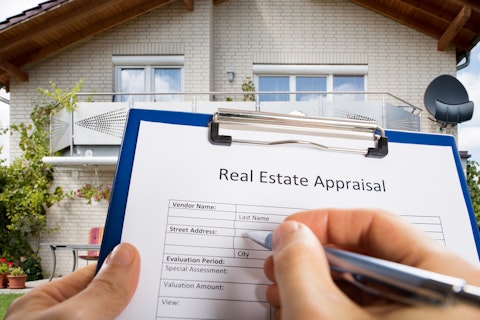Ready Capital Corporation (NYSE:RC) Q4 2022 Earnings Call Transcript February 27, 2023
Operator: Greetings, and welcome to the Ready Capital Corporation fourth quarter 2022 earnings conference call. At this time, all participants are in a listen-only mode. A question-and-answer session will follow the formal presentation As a reminder, this conference is being recorded. I would now like to turn the conference over to Andrew Ahlborn, Chief Financial Officer. Thank you. You may begin.
Andrew Ahlborn: Thank you, operator, and good morning to those of you on the call. Some of our comments today will be forward-looking statements within the meaning of the federal securities laws. Such statements are subject to numerous risks and uncertainties that could cause actual results to differ materially from what we expect. Therefore, you should exercise caution in interpreting and relying on them. We refer you to our SEC filings for a more detailed discussion of the risks that could impact our future operating results and financial condition. During the call, we will discuss our non-GAAP measures, which we believe can be useful in evaluating the company’s operating performance. These measures should not be considered in isolation or as a substitute for our financial results prepared in accordance with GAAP.
A reconciliation of these measures to the most directly comparable GAAP measure is available in our fourth quarter 2022 earnings release and our supplemental information, which can be found in the Investors section of the Ready Capital website. On today’s call, we are also joined by Adam Zausmer, Ready Capital’s Chief Credit Officer. I will now turn it over to Chief Executive Officer, Tom Capasse.
Tom Capasse: Thanks, Andrew. Good morning, and thank you for joining the call today. We have a lot of news and information to share. This morning, we announced a definitive agreement to acquire Broadmark Realty Capital, which we will discuss shortly. First, we’ll recap our fourth quarter and full year results. 2022 was another successful year of Ready Capital delivering on our long-term objectives. First, for our customers, Ready Capital remains a leading non-bank lender to CRE lower to middle market sponsors and small businesses nationwide, providing products across the property lifecycle. To that end, in 2022, we originated over 1,200 commercial and small business loans totaling $5.7 billion, and expanded our loan product offerings with the launch of our CRE construction program originating $220 million across four multifamily transactions at expected yields of 20%.
Notably, in the fourth quarter, we completed our OneTEAM initiative, consolidating relationship management, providing borrowers with seamless access to all of our products, better customized to their needs. Second, for our shareholders, we continue to set the company apart, as we both preserved and grew book value, while generating a dividend yield of 12%. 2022 marked another banner year, with 12.8% distributable return on average equity, distributable earnings per share of $1.87, and a 1.1 times dividend coverage. Importantly, and further setting us apart, book value per share is up 5% since the first quarter of 2020. To achieve the scale necessary to support our first and second objectives year-over-year, RC increased its capitalization 48% via both secondary markets and through our merger with Mosaic, a leading private credit lender focused on construction lending.
We also increased corporate debt 25% via the issuance of $220 million in corporate debt across two transactions. This growth continues to generate significant value for our shareholders. Now, moving to fourth quarter results, despite the economic headwinds, we originated $891 million of small balanced commercial loans or SBC loans, comprising $430 million of affordable multifamily, $190 million of bridge, $167 million of construction, and $104 million of Freddie and fixed. Multifamily remains our core focus, accounting for 93% of the quarter’s volume. We also were impacted by lower industry origination volume, but by focusing on strong underwriting efforts, we produced retained yields that were up 200 basis points from 2021 to 15%, with stronger credit metrics, average LTVs of 63%, and stabilized debt yields of 8%.
Entering 2023’s tenuous economic environment, in terms of investment capacity, it’s important to note, Ready Capital’s ability to pivot from direct lending to purchasing distressed bulk portfolios, mitigating any net interest margin drag from lower originations. Underscoring this, in the first quarter, we’ve experienced a pickup in offerings of distressed portfolios from banks. In our small business lending segment, fourth quarter originations of SBA 7(a) loans, equaled $137 million, capping another record year at $500 million in total production. Ready Capital is currently the second and sixth largest non-bank and overall SBA lender, respectively. This growth is due to expansion of our large loan program, as well as successful launch of our small lending program, which increased volume 300% to $66 million.
As we indicated on previous calls, we have made substantial investments in our proprietary fintech technology platform to support SBA lending. In addition to using the software for our own production, we have started to monetize the software with third party customers, and expect this to be an area of growth in upcoming years. Now, in terms of credit, from our vantage as a leading non-bank lender, we believe that while the overall economy is not technically in a recession, the commercial real estate market is in the throes of one, with significant sector differentiation, notably office. This has been reflected in recent deterioration in industry-wide credit metrics, particularly among non-bank lenders. Against this backdrop, Ready Capital’s historic strategy of diversification in small balanced lending and defensive sector focus in multifamily, has resulted in significant outperformance over time, and continued in this quarter.
First, in our originated CRE loan portfolio, comprising 84% of the total, 60-day plus delinquencies increased only two basis points to 1.9%, while high risk assets, those rated four to five on our one to five risk rating scale, were only 4.8% of the total. Furthermore, our focus on mid-market multifamily, which accounts for 81% of the current portfolio, is positioned to withstand the post-COVID and macroeconomic factors plaguing other sectors such as office, where we have a very modest 5% exposure in small ballots, average of 6.3 million loans. Second, in our acquired CRE in Mosaic loan portfolio comprising 10% of the total, much of which was distressed at purchase. 60-day plus delinquencies were only 10.1%, and high risk assets were 22%, mitigated by the remaining Mosaic contingency equity right reserve, and significant purchase discounts on non-performing loans or NPLs. Third, in our SBA portfolio, which comprises only 6% of the total exposure, 60-day delinquencies were a modest 1.4%, and high risk assets totaled 7%.
Despite the small equity allocation to SBA, the segment generates returns well in excess of the CRE lending business, which is a significant differentiator for Ready Capital. We also continue to demonstrate capital markets leadership, closing two CLOs since the third quarter. The first, a $860 million transaction with an 84 advance rate and AAA pricing at $283 basis points over the curve, closed in the fourth quarter. Subsequent to quarter end, we also closed a $590 million CRE CLO with AAA spreads tightening to 253 basis points over the curve. Our programs, which span six different shelves, have issued $12 billion over 12 years, and are a hallmark of our liquidity management, with demonstrated access to securitized debt in volatile markets.
Although we successfully navigated the challenging 2020 and 2022 market environments, we recognize the benefit of scale to achieve long-term market share goals. To that end, we are excited to announce the definitive merger agreement to acquire Broadmark Realty Capital, a specialty real estate finance company investing in opportunities throughout the small to middle market, generally in the $5 million to $75 million range per transaction, for which we will provide the following strategic and financial benefits upon the closing of the transaction. The first is scale. The merger creates one of the largest non-bank lenders in the commercial real estate market, and the fourth largest commercial real estate REIT, with expected total capitalization of nearly $3 billion.
The second is financial. The transaction is highly accretive and expected to increase 2024 to 2026 earnings per share, 10% to 15% above our annual 10% targeted return. Furthermore, book value dilution is modest at under 2%, and should fully recover in four to six quarters. Next is leverage reduction. Broadmark has only 0.1 turn of leverage. The merger is anticipated to provide over a full turn reduction in pro forma leverage while providing significant capital for growth in our core business. Next is liquidity improvement. Portfolio runoff plus immediate secured bank financing, provides $550 million of incremental forward 12-month liquidity, which can be deployed at high relative retain yields in the current stressed economic environment. Next is operating ratio improvement.
We expect to realize meaningful expense synergies in spreading fixed costs over a larger equity base. And finally, cost of capital enhancement. There is a potential reduction in cost of capital from a credit rewriting. The third benefit is strategic. Expansion of Ready Capital’s existing heavy transitional multifamily residential lending to smaller balanced loans in new geographic areas, notably the Pacific Northwest, Colorado, and Utah, while cross-selling existing Ready Capital products to Broadmark sponsors. Fourth is credit. We are confident that our underwriting of the Broadmark portfolio has adequately captured the necessary CECL reserves. We believe that with our asset management expertise and our experience of buying and working out NPLs, we are uniquely positioned to extract value from the Broadmark platform.
Finally, shareholder liquidity. Float will increase 63% to E160 million. With that, I’ll now turn it over to Andrew.
Andrew Ahlborn: Thanks, Tom, and good morning. Quarterly GAAP earnings and distributable earnings per share were $0.08 and $0.42, respectively. Distributable earnings of $51.6 million equates to an 11.4% distributable return on average stockholders’ equity. 2022 full year GAAP earnings and distributable earnings per share were $1.73 and $1.87, respectively, covering our dividend and equating to a 12.8% return on average stockholders’ equity. The main driver of the variance between our quarterly GAAP and distributed earnings was a $31 million increase to our CECL reserve. The increase in our CECL reserve was on our performing loan portfolio, and was driven by changes to the macroeconomic inputs in TREPS model. Importantly, the increased reserve is not a reflection of a deterioration of performance or credit in the portfolio.
And as Tom mentioned earlier, the originated portfolio remains very stable, with 60-plus day delinquencies at 1.9%. As of year-end, 86% of the portfolio was floating, leading to a $30.7 million increase in interest income absent PPP-related income. This increase was offset by an increase to interest expense, as leveraged increased slightly to 5.1 times, with proceeds being deployed into new origination. Realized gains were down quarter-over-quarter due to the liquidation of $146 million of CMBS loans, with an offsetting reversal of unrealized losses taken in previous quarters. The net impact of the sale on the quarter was a $4.4 million loss. This loss was offset by realized gains from the sale of SBA loans, which decreased 6% to $5.8 million due to a 9% decrease in average premiums.
Additionally, Redstone, a national multifamily affordable lender, had its largest quarter to date, adding $5.5 million in gains. Servicing income was lower by $3.5 million quarter-over-quarter due to an impairment of our SBA servicing asset. The impairment was primarily due to changes in the model’s discount rate, which are sensitive to movement in secondary pricing. Other income increased $4.8 million due to origination fees booked at Redstone. This business is historically seasonal, and fourth quarter originations were 140% of the previous three quarters combined. The improvement in operating expenses was due to an improvement in variable expenses related to production, as well as lower fixed compensation costs of approximately 10% due to targeted reductions in staffing.
On the balance sheet, liquidity remains healthy, with $164 million of total cash, and over $1.1 billion in unencumbered assets. We continue to balance the desire to carry higher liquidity levels through these markets, with an investment landscape at very attractive yields. Recourse leverage in the business declined to 1.5 times due to the CLO Tom mentioned earlier. And mark-to-market debt decreased to 14% of total debt. Book value per share was $15.20. The change is due to $0.30 per share related to CECL, with an offset of $0.15 per share related to the repurchase of 3.6 million shares at an average price of $10.34. As Tom mentioned, we are excited about the Broadmark transaction, which we expect to close by the end of the second quarter. The merger will add approximately $900 million in equity, is expected to be accretive to earnings within four to six quarters of closing, and provide in excess of $3 billion of liquidity for reinvestment over the next few years.
With that, we will open the line for questions.
See also 10 Hot Tech Stocks To Buy Now and 10 Hot Healthcare Stocks To Buy Now.
Q&A Session
Follow Grupo Radio Centro S A B De C V (TSE:RC)
Follow Grupo Radio Centro S A B De C V (TSE:RC)
Operator: Our first question is coming from the line of Crispin Love with Piper Sandler. Please proceed with your questions.
Crispin Love: Thanks, and good morning, Tom, Andrew, and Adam. First, on the Broadmark deal, can you just talk about how your strategy might shift at all as a result of the Broadmark deal? Just with Broadmark’s loans being very short in duration, do you expect to recycle that capital into construction loans at higher leverage than what Broadmark was doing, or do you expect to allocate that capital into – or excuse me, recycle that capital into other types of small balanced commercial loans that you’ve done over your history?
Tom Capasse: Yes, those are two good – let’s unpack that two ways, Crispin. And Adam, please chime in, but I just want to make two points there. The first is that the core Broadmark product, which is very analogous to our heavy transitional lending, and obviously with the Mosaic transaction last year, we’ve entered into construction lending, but it’s really – in terms of what we currently do, we currently do multifamily residential heavy transitional, and this is with an average balance, let’s say, of $15 million. The average balance of Broadmark is $7 million. So, it’s really just going downscale in terms of balance for us. And then the second component in terms of construction or heavy transitional, we are targeted to limit that to 20%.
Currently, we’re achieving the highest levered returns in the company, roughly 20% ROE in the construction product. So, with that, Adam, maybe comment on the current allocation and pro forma in terms of how we’re looking at managing that exposure.
Adam Zausmer: Yes, sure. The construction exposure today as a percentage of total commitments, will increase from approximately 6%, which is mostly the Mosaic merger and our new originations to about 15%, with the addition of the Broadmark portfolio. And as Tom mentioned, we have a target concentration for construction of about 20% of total CRE. So, we have room to book another 5% of construction loans up to that 20%. And we think there’ll be even greater opportunity for volumes of construction subject to stabilization of projects, and then successful execution of workout strategies.
Crispin Love: Okay, thank you. That’s all
Andrew Ahlborn: Hey, Crispin, yes, this is Andrew. The only thing I might add is, certainly the runoff of the portfolio increasing leverage slightly more in line with our historical leverage levels, is going to provide a lot of capital for reinvestment in our core channels. So, although the Broadmark product will become a smaller allocation into our balance sheet, the amount of liquidity that’s going to come up – the balance sheet and the transaction will really support those future investments in our existing core products for many, many quarters to come.
Crispin Love: Okay. So, it’s not – this deal isn’t quite like the Anworth deal that was a capital raise – that was kind of a backdoor capital raise, but instead, it will increase your construction, but then also give you kind of capital to invest elsewhere as well. Is that a fair representation?
Andrew Ahlborn: Yes.
Crispin Love: And then just one other one. Tom, you talked about in the prepared remarks, loan acquisition opportunities. Can you just give a little bit more detail there and what these distressed portfolios from banks that you mentioned, are looking like, and what types of discounts you have been or you think you could acquire some of these portfolios and loans?
Tom Capasse: Yes. I’ll let Adam comment on that as well, but basically, what we’re seeing, we see this in what I call a normal real estate cycle. You’re seeing bank regulators look to have banks with heavy concentrations of CRE in relation to tangible book value. I think that the target is, or the threshold for their CAMEL ratings is 250%. Once you achieve that level of 350, something like that, they look to reduce exposure. So, we’re seeing actually sales of performing or slightly distress stabilized portfolios at maybe call it, yes, like 10 to 15 point discounts. A lot of that’s interest rate, not credit. That’s one aspect. And then – so that’s the pruning going into the cycle to reduce CRE exposure in relation to tangible cap equity.





